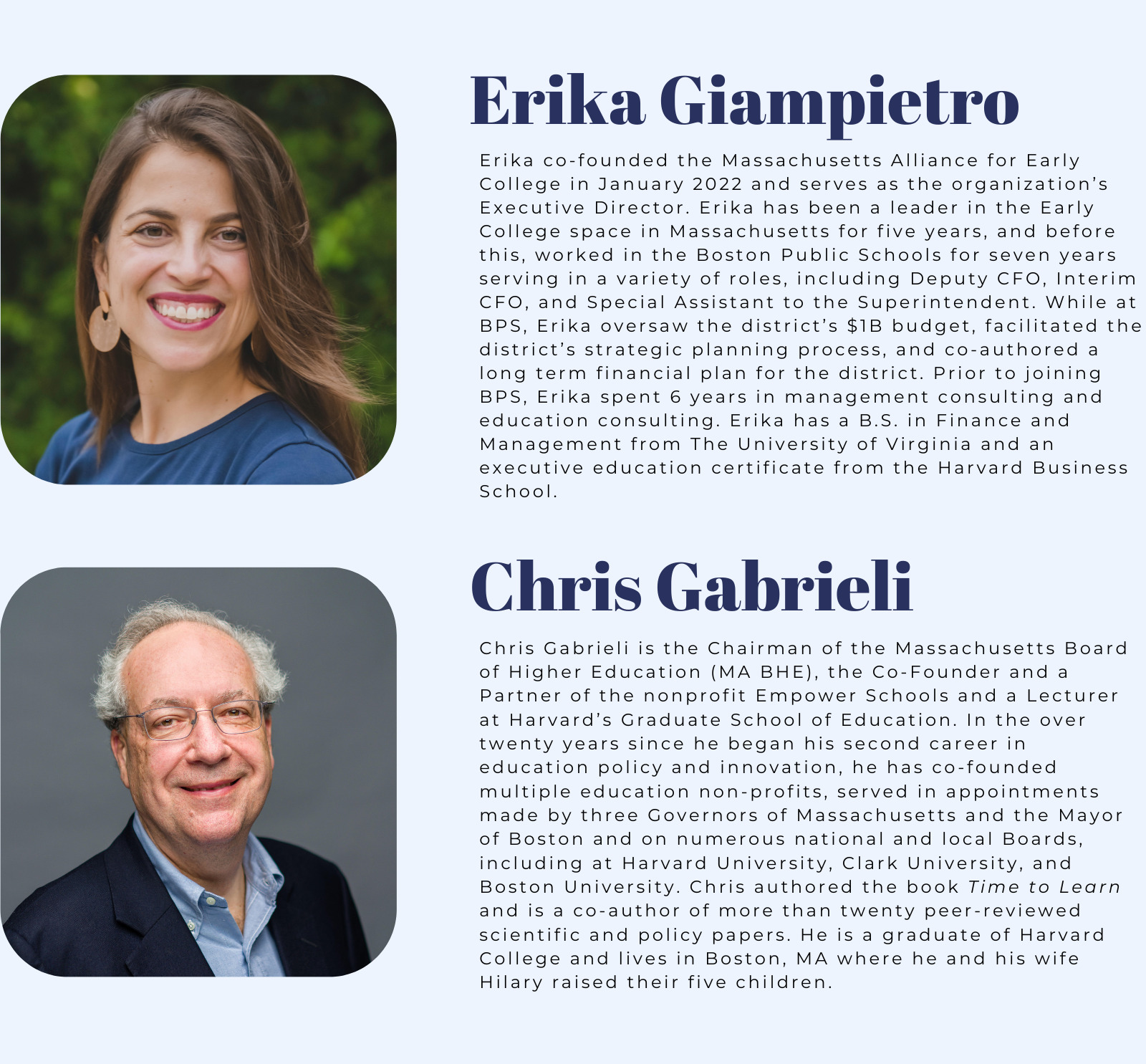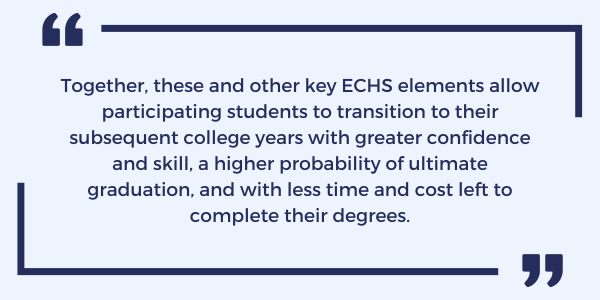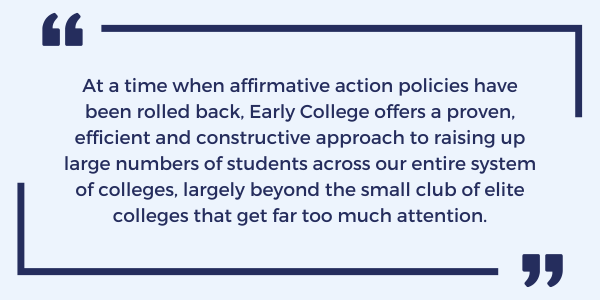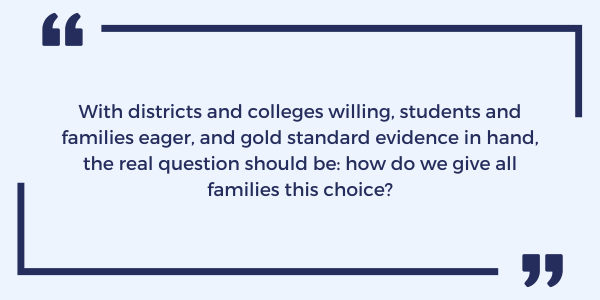
Across the US, and in the majority of all states, hundreds of thousands of public school students choose to attend one of more than 1,100 Early College High Schools (ECHS). These schools intentionally target students we have historically served least well when it comes to college success—low-income students, first generation college students, and students of color—and give them the opportunity to take sequences (often career-aligned) of college courses, taught by college instructors, that both count towards their high school requirements and provide them with transferable college credits.
Students in these ECHSs receive strong supports along academic, social-emotional and guidance dimensions. Smart scaffolding and sequencing of courses often starts off with college courses taught at high schools and culminates with courses taken mostly at college sites with other postsecondary students. Together, these and other key ECHS elements allow participating students to transition to their subsequent college years with greater confidence and skill, a higher probability of ultimate graduation, and with less time and cost left to complete their degrees.

Early College’s roots go as far back as the earliest days of college when students like Aaron Burr and Alexander Hamilton were able to enroll at Princeton and Columbia at ages 13 and 16 respectively. The modern era starts with the launch of the LaGuardia Early College High School on the campus of the LaGuardia Community College in 1974. The modern Early College High Schools were started to defy conventional assumptions and show that students then considered unlikely to be “college material” could in fact thrive and succeed if they were given a supportive path starting in high school. With a huge push from the Gates Foundation in the early 2000s resulting in the codifying of the ECHS model and the launch of about 250 more schools (especially in TX, NC, MI, OH and NY), the ECHS movement gained momentum and visibility.
Most current ECHS offerings in the country are small (typically about 100 students per grade) district high schools of choice, often physically sited on a college campus. Students who are interested can select the school as their high school choice, and the school district uses its overall approach to high school choice to govern how students are assigned. In some cases like North Carolina, admissions processes aim to ensure that a majority of students are traditionally underserved students. Most ECHSs seek out students whose academic profile would not be considered “college ready” or top performing and many often say they are ideal for students academically in the middle third—students who are currently likely to start but not to complete college.
Choice makes sense for ECHSs. Today, most (but not all) young people want to attend college. While there has been some deterioration in immediate college matriculation in MA and nationally, largely among lowest-income families, the majority of all high school graduates still go on to college. And in a recent MassINC poll, 70% of a representative sample of 1,000 parents of students in grades 6-12 saw college as what their child expects to do after high school. At the same time, we live in a moment where a lot of rhetoric—chiefly from opinion leaders who attended selective four-year colleges themselves and send their own children there—challenges what is called the “college for all” goal. And we see interest from many families in exploring direct-to-work paths to avoid the costs of college.
Even if a student and their family see college as their goal and the best means to a well-paying career, many families may still prefer traditional comprehensive high schools. Choosing ECHS usually means foregoing some of the usual features of a large, comprehensive high school on the curricular, extracurricular, and social dimensions. While ECHSs work to offer students opportunities in all those areas, their typically small size, and the added transportation challenges and higher rigor of college courses, force some tradeoffs. Many ECHS students, especially in their junior and senior years, welcome the offsetting and unique chance to share in college life, including the energy and great facilities of college campuses. All families should have the opportunity to weigh these considerations and make the best choice for their educational journeys.
In our approach in Massachusetts, most state-designated ECHS programs are operated within comprehensive high schools. Students electing to participate in the ECHS program are able to take college courses and receive added guidance and support but do so within the context of a typical high school, and so are able to participate in the curricular, extracurricular, and social dimensions of their high schools. Students and their families choose ECHS for a variety of reasons, but most are pursuing a North Star aspiration of college success. Some are also enticed by the excitement, relevance, and challenge of college level courses as well as the wider range of subjects available. Most would cite saving money on eventual college costs as well as time as key benefits, too.
We have worked together—alongside the leadership of our state legislature, state administration, educators in the field, and a coalition of more than 100 organizations—to foster a now six year-old Massachusetts Early College Initiative that has flourished. From a standing start, we have seen 50 partnerships between colleges and high schools earn state designation as Early College High Schools. These ECHSs qualify for financial and technical assistance to plan and launch as well as ongoing financial support for the costs of the incremental college courses. These ECHSs now serve about 7,000 students with encouraging early outcomes. We are serving the students we intended, with about two-thirds being students of color and about half low-income. Over 60% attend schools that predominantly serve low-income and/or Black and Hispanic students.
Importantly, researchers were able to conduct studies investigating the efficacy of Early College High Schools including with the gold standard method of comparing “lottery winners” versus “lottery losers” at oversubscribed pioneering ECHS sites. The results show that participants are considerably more likely to earn some form of college degree (typically one-quarter to one-third more often) over the next ten years at than non-participants and that they are likely to get there faster, allowing students to begin earning wages earlier than they otherwise would.
In Massachusetts, our ECHS graduates are 14 percentage points more likely (68% versus 54%) to go on to college compared to well-matched controls with identical race, gender, socioeconomic, high school makeup, test score and attendance patterns. They are also 14 percentage points (58% versus 44%) more likely to persist into a second year of college—a strong predictor of eventual graduation. These patterns hold up, and are even a little stronger, among students who are Black or Hispanic or low-income, regardless of their state test score levels. In fact, ECHS is actually one of the most validated education strategies we have available and earns the strongest ratings among postsecondary success on the US Department of Education’s “What Works Clearinghouse” website.
The public intellectual and Columbia University Professor of Linguistics John McWhorter recently wrote a column in the New York Times entitled “Early College is the Equalizer We Need.” As someone who cherished his own early college matriculation opportunity, he has spent time visiting early colleges and commented, “In discussions about alternatives to the standard public school trajectory for disadvantaged kids, charter schools have tended to dominate. However, early college programs should play a larger role in those conversations, given the high rates at which their students graduate from college.”
We agree. We see public schools and public and private colleges across Massachusetts and in many other states excited to offer this more personalized, equitable, and impactful alternative. We also agree with McWhorter that at a time when affirmative action policies have been rolled back, Early College offers a proven, efficient, and constructive approach to raising up large numbers of students across our entire system of colleges, largely beyond the small club of elite colleges that get far too much attention.

We believe that ECHS can and should be a choice available to most American students. Whereas most high school students can now opt to take a random college course or two (sometimes having to pay for it) while in high school through dual enrollment, these opportunities tend to be limited to students who historically and currently have the most access to a range of high-quality learning experiences. It is absolutely essential that an expansion of early college is executed through an equity lens so that students furthest from power can experience the numerous benefits of these programs. Policies across a handful of states have proven that Early College programs drive strong educational outcomes and more affordable and accessible pathways to higher education. With districts and colleges willing, students and families eager, and gold standard evidence in hand, the real question should be: how do we give all families this choice?
